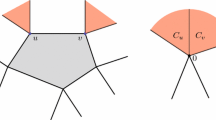Abstract
We show that a particular pivoting algorithm, which we call the lexicographic Lemke algorithm, takes an expected number of steps that is bounded by a quadratic inn, when applied to a random linear complementarity problem of dimensionn. We present two probabilistic models, both requiring some nondegeneracy and sign-invariance properties. The second distribution is concerned with linear complementarity problems that arise from linear programming. In this case we give bounds that are quadratic in the smaller of the two dimensions of the linear programming problem, and independent of the larger. Similar results have been obtained by Adler and Megiddo.
Similar content being viewed by others
References
I. Adler, “The expected number of pivots needed to solve parametric linear programs and the efficiency of the self-dual simplex method”, manuscript, Department of Industrial Engineering and Operations Research, University of California, Berkeley, California (May 1983).
I. Adler and S.E. Berenguer, “Random linear programs”, Operations Research Center Report No. 81-4, University of California, Berkeley, California (1981).
I. Adler and N. Megiddo, “A simplex-type algorithm solves linear programs of orderm × n in only O((min(m, n))2) steps on the average”, manuscript, Department of Industrial Engineering and Operations Research, University of California, Berkeley, and Department of Computer Science, Stanford University, Stanford, California (November 1983).
I. Adler and N. Megiddo, “A simplex algorithm whose average number of steps is bounded between two quadratic functions of the smaller dimension”, in:Proceedings of the 16th annual ACM symposium on theory of computing (1984), pp. 312–323.
C. Blair, “Random linear programs with many variables and few constraints”, Faculty Working Paper No. 946, College of Commerce and Business Administration, University of Illinois at Urbana-Champaign, Illinois (April 1983).
K.H. Borgwardt, “Some distribution-independent results about the asymptotic order of the average number of steps of the simplex method“,Mathematics of Operations Research 7 (1982) 441–462.
K.H. Borgwardt, “The average number of pivot steps required by the simplex-method is polynomial“,Zeitschrift fur Operations Research 26 (1982) 157–177.
M. Haimovich, “The simplex algorithm is very good! - On the expected number of pivot steps and related properties of random linear programs”, manuscript, Columbia University, New York, New York (April 1983).
C.E. Lemke, “Bimatrix equilibrium points and mathematical programming“,Management Science 11 (1965) 681–689.
J.H. May and R.L. Smith, “Random polytopes: their definition, generation, and aggregate properties“,Mathematical Programming 24 (1982) 39–54.
N. Megiddo, “The probabilistic analysis of Lemke's algorithm for the linear complementarity problem”, manuscript, Department of Computer Science, Stanford University, Stanford, California (September 1983).
N. Megiddo, “Improved asymptotic analysis of the average number of steps performed by the self-dual simplex algorithm”, manuscript, Department of Computer Science, Stanford University, Stanford, California (September 1983).
N. Megiddo, “On the expected number of linear complementarity cones intersected by random and semi-random rays”, manuscript, Department of Computer Science, Stanford University, Stanford, California (November 1983).
T.S. Motzkin, “The probability of solvability of linear inequalities“, in: H.A. Antosiewicz, ed.,Proceedings of the second symposium in linear programming (National Bureau of Standards and Directorate of Management Analysis, USAF, 1955) pp. 607–611.
A. Prekopa, “On the number of vertices of random convex polyhedra“,Periodica Mathematica Hungarica 2 (1972) 259–282.
R. Saigal, “On some average results for linear complementarity problems”, manuscript, Department of Industrial Engineering and Management Sciences, Northwestern University, Evanston, Illinois (August 1983).
S. Smale, “On the average number of steps of the simplex method of linear programming“,Mathematical Programming 27 (1983) 241–262.
S. Smale, “The problem of the average speed of the simplex method“, in: A. Bachem, M. Grotschel and B. Korte, eds.,Mathematical programming: the state of the art (Springer-Verlag, Berlin-Heidelberg-New York-Tokyo, 1983) pp. 530–539.
M.J. Todd, “Complementarity in oriented matroids”, to appear inSIAM Journal on Algebraic and Discrete Methods.
M.J. Todd, “Linear and quadratic programming in oriented matroids”, Technical Report No. 565, School of Operations Research and Industrial Engineering, Cornell University, Ithaca, New York (March 1983).
L. Van der Heyden, “A variable dimension algorithm for the linear complementarity problem“,Mathematical Programming 19 (1980) 328–346.
Author information
Authors and Affiliations
Additional information
Research partially funded by a fellowship from the Alfred Sloan Foundation and by NSF Grant ECS82-15361.
Rights and permissions
About this article
Cite this article
Todd, M.J. Polynomial expected behavior of a pivoting algorithm for linear complementarity and linear programming problems. Mathematical Programming 35, 173–192 (1986). https://doi.org/10.1007/BF01580646
Received:
Revised:
Issue Date:
DOI: https://doi.org/10.1007/BF01580646




